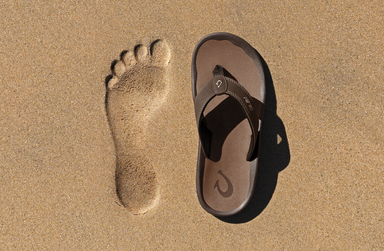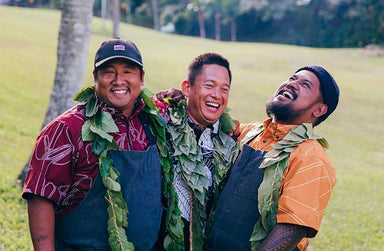Anywhere Aloha
OluKai
Nov 19, 2014
Subsistence fishing
[caption id="attachment_1464069" align="aligncenter" width="604"]

©istockphoto/phiksos[/caption]
For centuries in the Pacific Islands, families have paid close attention to their part in maintaining a balance with nature’s abundance, abiding by the laws of give and take in order to preserve all the species involved. Subsistence fishing—the feeding of one’s family, one’s ‘ohana—was never taken to excess, ensuring that only enough fish were taken to feed the family with perhaps a slight reserve for future days. Survival may have relied as well on selling a small number of fish, tending small-scale agriculture, and other work.
It’s not sport fishing so subsistence fishing falls into what some people refer to as
artisan fishing. Artisan, in this case, indicates the use of throw-nets, spears, simple fishing boats, classic rod-and-reel fishing—truly nothing of a high-tech nature. Artisan fishing means you only take what you need and what the ocean can sustainably spare. You might say it’s a form of living off the land that also requires sustainable practices. Early Hawaiians always maintained that fishing was an ancient art in their lands.
By the way, men do all the fishing, right? We’ll see.
In today’s world, with over seven billion people on the planet, crowded with cities that overflow into the countryside, it’s not so easy to carve out a space where you can fish with enough sustenance for your family. If you can live on property that is not taxed, or not taxed beyond your means, then the question arises about whether there are enough fish to support this lifestyle. Commercial fishing has not left very many areas untouched. A Stanford University study stated that fishing (subsistence, commercial, recreational, and aquaculture) in the Hawaiian Islands remained at sustainable levels for four centuries prior to the arrival of Europeans. Now we have to pay more attention.
Is there hope? Recently, the Department of Land and Natural Resources in Honolulu supported investigating setting up a Hā‘ena Community-Based Subsistence Fishing Area (CBSFA) on the island of Kaua‘i. The intent behind this is for the “purpose of managing and protecting fish stocks, and of reaffirming traditional and customary native Hawaiian subsistence fishing practices within the Ahupua‘a of Hā‘ena” (an Ahupua‘a, in Hawaiian terms, is akin to a specific watershed). This is encouraging news as it can create a model for other areas to copy.
Granted, it is easier to set up CBSFAs in
less populated regions, which are also more amenable to subsistence fishing since there are more fish available than in densely populated regions, but at least there is movement in that direction. An additional CBSFA has been considered for Mo‘omomi on the northwest side of Molokai‘i.
The Food and Agriculture Organization of the United Nations (FAO), in their Fisheries of the Pacific Islands report in 2011, has coastal subsistence fishing statistics for at least fifteen of the Pacific Island countries. At the top of the take, at about 30,000 metric tons annually, is the large (by comparison) Papua New Guinea. Working our way through them, including, for example, Fiji (17,400), Samoa (4,495), Palau (1,250), then to Niue (140), we can see that coastal subsistence fishing takes do exist, but industrial-strength fishing needs to be held in check if subsistence fishing is to increase. Island countries like Palau are setting large no-take regions when fish stocks fall below sustainable levels. Others can follow suit.
They don’t. Do all the fishing. Men. A University of Hawai‘i study, by L. Lambeth, et al., looked across a variety of
cultures. They found that in Samoa women comprised about 18% of the village fishers, pulling in 23% of the total weight of seafood. In Tuvalu, women are the main processors and do most of the marketing of the fish. In Palau, women bring in significant harvest around the reefs—sea urchin, mollusk, crab, sea cucumber, and over fifteen species of fish, plus they have ventured out into small motorboats. On Kosrae, in Micronesia, women provide much of the seafood through the use of nets, hand lines, and gleaning from reefs. In Fiji, women dominate the subsistence fishing. Soon, the men will be home minding the kids and preparing the meals!
 ©istockphoto/phiksos[/caption]
For centuries in the Pacific Islands, families have paid close attention to their part in maintaining a balance with nature’s abundance, abiding by the laws of give and take in order to preserve all the species involved. Subsistence fishing—the feeding of one’s family, one’s ‘ohana—was never taken to excess, ensuring that only enough fish were taken to feed the family with perhaps a slight reserve for future days. Survival may have relied as well on selling a small number of fish, tending small-scale agriculture, and other work.
It’s not sport fishing so subsistence fishing falls into what some people refer to as artisan fishing. Artisan, in this case, indicates the use of throw-nets, spears, simple fishing boats, classic rod-and-reel fishing—truly nothing of a high-tech nature. Artisan fishing means you only take what you need and what the ocean can sustainably spare. You might say it’s a form of living off the land that also requires sustainable practices. Early Hawaiians always maintained that fishing was an ancient art in their lands.
By the way, men do all the fishing, right? We’ll see.
In today’s world, with over seven billion people on the planet, crowded with cities that overflow into the countryside, it’s not so easy to carve out a space where you can fish with enough sustenance for your family. If you can live on property that is not taxed, or not taxed beyond your means, then the question arises about whether there are enough fish to support this lifestyle. Commercial fishing has not left very many areas untouched. A Stanford University study stated that fishing (subsistence, commercial, recreational, and aquaculture) in the Hawaiian Islands remained at sustainable levels for four centuries prior to the arrival of Europeans. Now we have to pay more attention.
Is there hope? Recently, the Department of Land and Natural Resources in Honolulu supported investigating setting up a Hā‘ena Community-Based Subsistence Fishing Area (CBSFA) on the island of Kaua‘i. The intent behind this is for the “purpose of managing and protecting fish stocks, and of reaffirming traditional and customary native Hawaiian subsistence fishing practices within the Ahupua‘a of Hā‘ena” (an Ahupua‘a, in Hawaiian terms, is akin to a specific watershed). This is encouraging news as it can create a model for other areas to copy.
Granted, it is easier to set up CBSFAs in less populated regions, which are also more amenable to subsistence fishing since there are more fish available than in densely populated regions, but at least there is movement in that direction. An additional CBSFA has been considered for Mo‘omomi on the northwest side of Molokai‘i.
The Food and Agriculture Organization of the United Nations (FAO), in their Fisheries of the Pacific Islands report in 2011, has coastal subsistence fishing statistics for at least fifteen of the Pacific Island countries. At the top of the take, at about 30,000 metric tons annually, is the large (by comparison) Papua New Guinea. Working our way through them, including, for example, Fiji (17,400), Samoa (4,495), Palau (1,250), then to Niue (140), we can see that coastal subsistence fishing takes do exist, but industrial-strength fishing needs to be held in check if subsistence fishing is to increase. Island countries like Palau are setting large no-take regions when fish stocks fall below sustainable levels. Others can follow suit.
They don’t. Do all the fishing. Men. A University of Hawai‘i study, by L. Lambeth, et al., looked across a variety of cultures. They found that in Samoa women comprised about 18% of the village fishers, pulling in 23% of the total weight of seafood. In Tuvalu, women are the main processors and do most of the marketing of the fish. In Palau, women bring in significant harvest around the reefs—sea urchin, mollusk, crab, sea cucumber, and over fifteen species of fish, plus they have ventured out into small motorboats. On Kosrae, in Micronesia, women provide much of the seafood through the use of nets, hand lines, and gleaning from reefs. In Fiji, women dominate the subsistence fishing. Soon, the men will be home minding the kids and preparing the meals!
©istockphoto/phiksos[/caption]
For centuries in the Pacific Islands, families have paid close attention to their part in maintaining a balance with nature’s abundance, abiding by the laws of give and take in order to preserve all the species involved. Subsistence fishing—the feeding of one’s family, one’s ‘ohana—was never taken to excess, ensuring that only enough fish were taken to feed the family with perhaps a slight reserve for future days. Survival may have relied as well on selling a small number of fish, tending small-scale agriculture, and other work.
It’s not sport fishing so subsistence fishing falls into what some people refer to as artisan fishing. Artisan, in this case, indicates the use of throw-nets, spears, simple fishing boats, classic rod-and-reel fishing—truly nothing of a high-tech nature. Artisan fishing means you only take what you need and what the ocean can sustainably spare. You might say it’s a form of living off the land that also requires sustainable practices. Early Hawaiians always maintained that fishing was an ancient art in their lands.
By the way, men do all the fishing, right? We’ll see.
In today’s world, with over seven billion people on the planet, crowded with cities that overflow into the countryside, it’s not so easy to carve out a space where you can fish with enough sustenance for your family. If you can live on property that is not taxed, or not taxed beyond your means, then the question arises about whether there are enough fish to support this lifestyle. Commercial fishing has not left very many areas untouched. A Stanford University study stated that fishing (subsistence, commercial, recreational, and aquaculture) in the Hawaiian Islands remained at sustainable levels for four centuries prior to the arrival of Europeans. Now we have to pay more attention.
Is there hope? Recently, the Department of Land and Natural Resources in Honolulu supported investigating setting up a Hā‘ena Community-Based Subsistence Fishing Area (CBSFA) on the island of Kaua‘i. The intent behind this is for the “purpose of managing and protecting fish stocks, and of reaffirming traditional and customary native Hawaiian subsistence fishing practices within the Ahupua‘a of Hā‘ena” (an Ahupua‘a, in Hawaiian terms, is akin to a specific watershed). This is encouraging news as it can create a model for other areas to copy.
Granted, it is easier to set up CBSFAs in less populated regions, which are also more amenable to subsistence fishing since there are more fish available than in densely populated regions, but at least there is movement in that direction. An additional CBSFA has been considered for Mo‘omomi on the northwest side of Molokai‘i.
The Food and Agriculture Organization of the United Nations (FAO), in their Fisheries of the Pacific Islands report in 2011, has coastal subsistence fishing statistics for at least fifteen of the Pacific Island countries. At the top of the take, at about 30,000 metric tons annually, is the large (by comparison) Papua New Guinea. Working our way through them, including, for example, Fiji (17,400), Samoa (4,495), Palau (1,250), then to Niue (140), we can see that coastal subsistence fishing takes do exist, but industrial-strength fishing needs to be held in check if subsistence fishing is to increase. Island countries like Palau are setting large no-take regions when fish stocks fall below sustainable levels. Others can follow suit.
They don’t. Do all the fishing. Men. A University of Hawai‘i study, by L. Lambeth, et al., looked across a variety of cultures. They found that in Samoa women comprised about 18% of the village fishers, pulling in 23% of the total weight of seafood. In Tuvalu, women are the main processors and do most of the marketing of the fish. In Palau, women bring in significant harvest around the reefs—sea urchin, mollusk, crab, sea cucumber, and over fifteen species of fish, plus they have ventured out into small motorboats. On Kosrae, in Micronesia, women provide much of the seafood through the use of nets, hand lines, and gleaning from reefs. In Fiji, women dominate the subsistence fishing. Soon, the men will be home minding the kids and preparing the meals!





